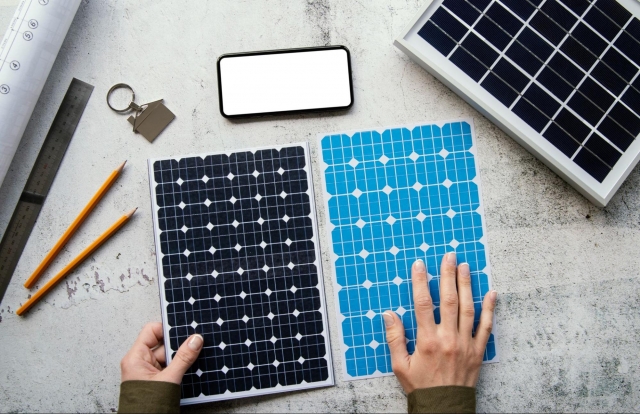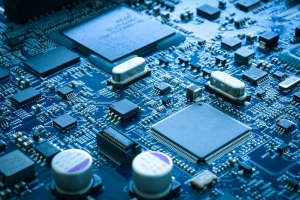The commercial sector of India is adopting solar power as an answer to rising power expenses and sustainability requirements. A comprehensive understanding of different solar panel varieties is necessary for companies planning solar energy investments to achieve the national goal of 500 GW non-fossil fuel capacity by 2030. The solar panel market in India consists mainly of four categories: monocrystalline panels, polycrystalline panels, thin-film panels, and PERC panels. Solar panels present unique sets of benefits that distinguish them from one another through their operational efficiency levels and economic requirements and their compatibility with particular industrial uses. The energy output of a company and its return on investment depend heavily on selecting the proper solar panel technology. The subsequent content will explore these solar panel variations by explaining their characteristics to support commercial energy planning.
Monocrystalline Solar Panels
Overview
These solar panels consist entirely of one crystal structure made from silicon which offers superior performance together with longevity in operation.
Advantages
The efficiency rates between 18–22% that monocrystalline solar panels deliver allow business owners to utilize suitable solutions for constrained rooftop areas.
These solar panels demonstrate a lifespan exceeding 25 years, during which their performance remains virtually undiminished.
Industrial Solar Panels demonstrate excellent performance ability throughout areas with limited illumination or when shadowed by clouds.
Disadvantages
The production costs for lower-cost materials result in increased prices for these solar panels.
The efficiency of these panels shows minor reductions only within extreme hot conditions but they remain more efficient than other solar panel types.
Best for Commercial spaces with limited roof area and high energy requirements.
Polycrystalline Solar Panels
Overview
The manufacturing process using many silicon crystals produces cheaper solar panels yet their efficiency stands slightly behind monocrystalline panels.
Advantages
Due to their affordable nature, these solar panels serve as an economical option when compared to other types.
Cost reductions result from an easy production procedure.
Indian weather conditions affect these solar panels positively because they function well at high temperatures.
Disadvantages
The power generation process of polycrystalline panels demands greater physical space because their efficiency rates fall within the 15–17% range.
The estimated operational timeframe for polycrystalline solar panels turns out to be shorter than that of monocrystalline panels.
Best for businesses with larger rooftops and moderate budgets.
Thin-Film Solar Panels
Overview
Solar cells consisting of photovoltaic thin layers that use cadmium telluride or amorphous silicon materials create a lightweight flexible system.
Advantages
These photovoltaic products exhibit simple installation properties together with their ability to function on unexpected surfaces because of their flexible nature.
Under high temperatures, this technology preserves its operational stability.
Commercial buildings that want appealing aesthetics choose these panels because of their modern appearance.
Disadvantages
The power generation efficiency requires six to seven times more space as the panels deliver only 10-12% conversion rates.
A shorter Lifespan is one of their disadvantages since they will endure accelerated degradation when contrasted with silicon-based panels.
Best for businesses with large rooftops or industrial buildings with lightweight structures.
PERC (Passivated Emitter and Rear Cell) Solar Panels
Overview
The improved version of conventional monocrystalline and polycrystalline solar panels known as PERC brings better energy capture abilities and operational efficiency.
Advantages
These solar panels rank among the best due to their efficiency rates, which fall between 20–24%.
The technology performs optimally under low-light conditions by delivering additional power output.
The higher efficiency allows the installation of reduced solar panel numbers required to satisfy energy needs.
Disadvantages
PERC panels command higher costs than the standard polycrystalline panels in the market.
The incorporation of advanced technology during manufacturing leads to increased costs of production.
Best for
Corporate entities that need to maximize efficiency together with long-term savings benefit from these solar energy solutions.
The Selection Process for a Business-Fit Solar Panel
Factors to Consider
Execute a power consumption assessment to find out your business needs regarding solar panels.
An organization running short on rooftop space should select either monocrystalline or PERC panels because of their advanced energy efficiency features.
Polycrystalline, together with thin-film solar panels, present financially viable solutions for purchases.
The solar panels which perform best under low light conditions include Monocrystalline as well as PERC while thin-film panels demonstrate superior performance at high temperatures.
Higher long-term savings can be achieved through investment in efficient solar panels, although the initial costs are more expensive.
Future Trends in Solar Panel Technology
Bifacial Solar Panels
Solar cells that absorb light energy from two sides, increase power generation capabilities by approximately 30%.
Ideal for commercial installations with reflective surfaces.
Perovskite Solar Cells
This technology demonstrates superior performance, together with budget-friendly production excellence, than conventional silicon panel systems.
The technology represents a revolutionary approach to reshaping solar energy systems in the upcoming years.
Floating Solar Panels
These panels find their position on water bodies as a way to maximize available land space.
The government of India is developing major floating solar installations across the country for maximum energy output.
Government Initiatives and Incentives
The Indian government presents multiple incentives for the implementation of solar energy by businesses.
A business can avail of accelerated depreciation by claiming up to 40% initial year depreciation benefits.
A number of state governments provide financial assistance with tax advantages for commercial solar projects.
Commercial entities that have solar systems receive financial benefits through net metering policies, which enable them to supply surplus solar power to the power grid and gain monetary compensation.
The Key Takeaway
A commercial establishment must make the right choice when deciding on solar panel investments. Businesses require expert steering, dependable solutions to achieve maximum performance, and prolonged savings during effortless installation. Users can obtain customized solar power solutions from Sunsure Energy, which matches their business specifications as a leading solar energy provider in India. The solar energy expertise of Sunsure Energy, together with its market-leading technology, enables businesses to smoothly transition toward renewable power. Sunsure Energy details multiple solar panel solutions and sustainable energy options through this guide that leads businesses toward greener prospects.






